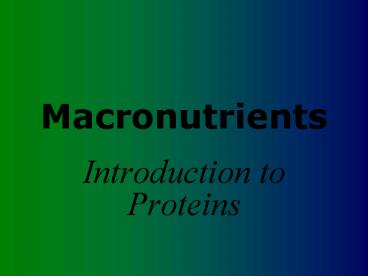Macronutrients - PowerPoint PPT Presentation
1 / 17
Title:
Macronutrients
Description:
The monomers (building blocks) of proteins are AMINO ACIDS. Monomer = amino acid ... essential and nonessential when describing the monomers of proteins? ... – PowerPoint PPT presentation
Number of Views:320
Avg rating:3.0/5.0
Title: Macronutrients
1
Macronutrients
- Introduction to Proteins
2
Protein Models
- Describe, in general, what you were doing from
step to step. - What type of bond forms between amino acid,
forming proteins? - What two elements are these bonds between?
3
1A B. Are proteins a macronutrient?
- Yes, they provide 4 kcals/g and you need them in
significant amounts.
4
2. Identify the monomers of proteins.
- The monomers (building blocks) of proteins are
AMINO ACIDS. - Monomer amino acid
- Polymer protein
5
3A B Amino acids proteins always contain C,
H, O, and NThey are organic! Carbon Hydrogen
6
COMMON AMINO ACID STRUCTURE
7
(No Transcript)
8
4a. What special kind of bonds hold proteins
together?
- Peptide bonds
9
4B. DESCRIBE A PEPTIDE BOND
- A peptide bond is formed between nitrogen of one
amino acid and the carbon of the next. - More specifically, the nitrogen of the AMINO
group (NH2) and the carbon on the acid/CARBOXYL
group (COOH)
10
(No Transcript)
11
5a. What is the difference between essential and
nonessential when describing the monomers of
proteins?
- Nonessential Your body can produce these amino
acids by itself. It is NOT ESSENTIAL that a
person takes them in through their diet. - Essential Your body can NOT produce these by
itself. It IS ESSENTIAL that a person take them
in through their diet.
12
5b. What is the number of amino acids the human
body can produce?
- The human body can produce 11 of the 20 standard
amino acids. - That means 11 are NONESSENTIAL and 9 are
ESSENTIAL.
13
6. Compare complete and incomplete proteins.
- Incomplete LACKS one or more of the ESSENTIAL
amino acids. - Most vegetable protein is considered incomplete
- Complete CONTAINS all nine of the essential
amino acids. - Protein from animal sources, such as meat and
milk, is called complete
14
7A B. What is another name for proteins?
- Polypeptide
- Poly many and peptide peptide bonds)
- MANY PEPTIDES
- Peptide bonds are almost exclusive to proteins
- Not many other molecules in the body have peptide
bonds
15
8. List and explain 5 functions of proteins.
- Build, keep up, and replace the tissues in your
body. - Acts as hormones (sending messages around the
body) - Antibodies (immune system helps fight
disease/infection) - Hemoglobin (responsible for delivering oxygen to
your blood cells) - Signaling cells what to do and when to do it
- Transporting substances around the body through
cell membranes - ENZYMES!!!!
16
9. What are some food sources of proteins?
- Eggs
- Milk
- Beef, poultry, pork and lamb
- Fish and shellfish
- Dairy products, including cottage cheese, cheese,
yogurt and milk - Dry beans, peas, oats and legumes
- Tofu and soy products
- Nuts and seeds
17
Nutrition Sleuth
- http//wps.aw.com/bc_blake_nutrition_1/75/19279/49
35628.cw/index.html









![[DOWNLOAD]⚡️PDF✔️ The Everything Guide to Macronutrients: The Flexible Eating Plan for Los PowerPoint PPT Presentation](https://s3.amazonaws.com/images.powershow.com/10085856.th0.jpg?_=20240725107)
![[DOWNLOAD]⚡️PDF✔️ The Everything Guide to Macronutrients: The Flexible Eating Plan for Losing Fa PowerPoint PPT Presentation](https://s3.amazonaws.com/images.powershow.com/10073839.th0.jpg?_=20240705071)
![[READ] The Everything Guide to Macronutrients: The Flexible Eating Plan for Losing Fat and Getting Lean (Everything® Series) PowerPoint PPT Presentation](https://s3.amazonaws.com/images.powershow.com/10081642.th0.jpg?_=20240719081)



















